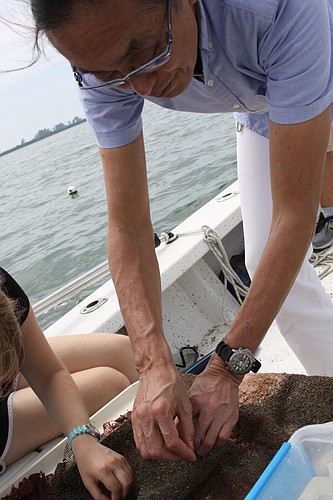- May 4, 2024
-
-
Loading

Loading

Mote Marine Laboratory and Aquarium isn’t just a local point of pride; it’s an institution that has become a model for the rest of the world. The Research Institute for Humanity and Nature (RIHN) in Kyoto, Japan, is currently conducting a five-year study of Mote as a model for a residential research institution.
“A residential research institution is an institution that is embedded into part of the community,” Mote President and CEO Michael Crosby said. “The researchers at RIHN are intrigued by Mote and how it’s really been able to thrive in its 60-year history in great part with the relationship with the community in southwest Florida.”
RIHN is studying institutes around the world, including Turkey, Japan and Malawi.
“They’re looking at some different models for how communities engage very directly with research institutes,” Crosby said. “They’re looking at if a Mote model is one that can be used potentially for implementation around the world in other areas.”
The Japanese researchers visit once every three months, and Mote scientists visit Japan once a year. There will be a workshop at Mote this fall during which the Japanese colleagues will look in-depth at the relationship between Mote and the Sarasota community.
“We try to engage the community is every aspect of what we do,” Crosby said. “More than 1,000 volunteers are an integral part of our every facet, whether it’s engaging local fisherman, nonprofit groups or the community.”
Researchers are specifically focusing on Mote’s work to restore local scallop populations and how the lab engages with the local community. There are one to two years left of the study.
“Some scientists try to be a little confident that their scientific approach is the best and perhaps don’t have the appreciation for the value of knowledge people have working on the water or those who have been living here for generations,” Crosby said. “It’s important to value the sharing of knowledge and working together.”
RIHN became interested in Crosby’s work through a research paper he wrote in the early 1990s when he was on the advisory board for the Institute of Subtropical Research. The paper was translated into Japanese, and RIHN invited Crosby to Japan five years ago.
“People all over the world are looking at Mote and Sarasota as a model for the rest of the world to emulate,” Crosby said. “It’s a wonderful thing going on right here in Sarasota and another example of what makes this place such a special place, working together for the benefit of our community and the environment we treasure.”